
เส้นทางเดิน ชิโดะริกะฟุชิ
Tomoko Kamishimaเส้นทางเดิน ชิโดะริกะฟุชิเป็นหนึ่งในสถานที่ที่ ได้รับความนิยมมากที่สุดในการชมดอกซากุระในญี่ปุ่น เส้นทางเดิน 770 เมตรนี้เรียงรายไปด้วยต้นซากุระ 260 ต้น

The Chidorigafuchi Trench is one of the best places in Tokyo to see the cherry blossoms in spring, from late March to early April. This 700-meter walk next to the Imperial Palace moat offers beautiful scenery and great opportunities for discovery.
During the popular cherry blossom season, the paths along the moat are colored pink by hundreds of cherry trees. The trees are also lit at night during the Chiyoda Sakura Cherry Blossom Festival. A little later in the year the surface of the water is almost completely covered by falling petals. Many couples rent boats and take a romantic excursion through this pink wonderland.
Nearby attractions include Yasukuni Shrine, Showa National Memorial Museum, Nippon Budokan, and the Jimbocho Bookseller District.
Chidorigafuchi is directly adjacent to Exit 2 at Kudanshita Station.

เส้นทางเดิน ชิโดะริกะฟุชิเป็นหนึ่งในสถานที่ที่ ได้รับความนิยมมากที่สุดในการชมดอกซากุระในญี่ปุ่น เส้นทางเดิน 770 เมตรนี้เรียงรายไปด้วยต้นซากุระ 260 ต้น
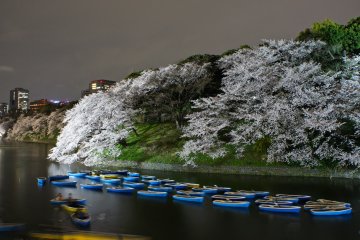
ในระหว่างที่ผมแวะไปที่โตเกียวในปี 1998 นั้น โชคได้เข้าข้างผม ที่มาถึงในเดือนมีนาคม และอยู่ที่นี่จนถึงเดือนเมษายน ประสบการณ์แรกนั้นไม่มีการวางแผนไว้ ผมแวะไปที่สถานทูตอินเดียในคุดันชิตะ และนั่นคือเวลาที่ผมเห็นดอกซากุระที่กำลังเบ่งบานอย่างเต็มที่ในสวนชิโดะริกะฟุชิ
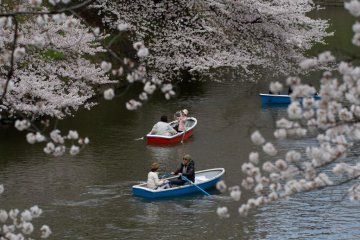
ชิโดะริกะฟุชิ (Chidorigafuchi) คูเมืองรอบอิมพีเรียลพาเลซ เป็นหนึ่งในสถานที่สำคัญสำหรับฮานามิ (ชมดอกซากุระ) กลางเมืองโตเกียว
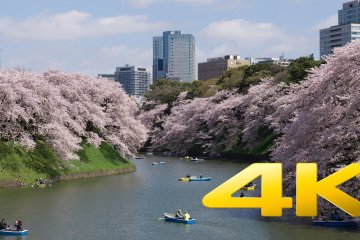
ตั้งอยู่ใกล้กับพระราชวังอิมพีเรียลและศาลเจ้ายะสุคุนิ ชิโดะริงะฟุชิ (Chidorigafuchi) คือสุสานแห่งชาติของประเทศญี่ปุ่น และเป็นอนุสรณ์สถานสำหรับบุคคลนิรนามที่เสียชีวิตได้สงครามโลกครั้งที่สองประมาณ 350,000 คน แม้ว่าจะมีเรื่องราวในอดีตที่เศร้าสลด แต่ปีละครั้ง ชิโดะริงะฟุชิ ก็กลายมาเป็นสถานที่ยอดนิยมในกรุงโตเกียวสำหรับฮานามิ หรือการชมดอกซากุระ ไม่ว่าจะเป็นการเดินเล่นรอบๆ คูเมือง หรือการพายเรือ หากคุณมีความอดทนพอในการรอคิวเช่าเรือ

Oakwood Premier Tokyo comes from a brand of standout luxury hotel & service apartments right at the heart of the Tokyo metropolis. It is located in the business hub of Marunouchi with JR Tokyo Station in close proximity. This will allow guests and travelers to easily access the city's extensive transport network and visit various landmarks such as Imperial Palace, Tsukiji Fish Market, Ginza and Shopping District. Boasting 123 luxurious apartments on the upper floors of a multi-serviced complex, each room offers a magnificent view of the city, not to mention all furnished and a fully-equipped kitchen set which is rarely seen in your everyday service apartment. Without doubt, these spacious tranquil retreats are curated to give you the amenities and services of a luxury hotel and a feeling of home. They are good options for both business executives and leisure travelers from one night of a short-stay to a few weeks/months of mid-to-long-term stay.

NOHGA HOTEL AKIHABARA TOKYO is conveniently located in the midst of the electric town Akihabara, also known as the capital of manga and anime. In addition, this neighborhood has an abundance of tech shops, maid cafes and a variety of restaurants. With just a 6-minute walk away from Akihabara station, it provides easy access to explore other areas nearby such as Ueno and Asakusa. This hotel embodies the rich cultures of music, art and food. Nohga’s concept of music is derived from Akihabara’s local history, starting as a district of radio and wireless component merchants in the late 1920s. The artistic and luxurious space throughout the hotel is achieved by featuring art and amenities designed in collaboration with craftsmen from around Japan. As for the food menu, it’s seasonal fresh ingredients are sourced domestically. The glasses and dinnerware served are collaborations with stores in the surrounding area. All 120 non-smoking guest rooms feature an ensuite bathroom with a rain shower, in-room safety box, mini fridge, USB plugs, free Wi-Fi, a high-quality bluetooth speaker and flatscreen TV with original music and film. The lounge area and a compact 24-hour gym can be found near the reception on the second floor. Services include laundry (from 2,750JPY) and a 24-hour front desk with a check-in time of 3PM and check-out time of 11AM. For sightseeing you can rent a Tokyobike for the day (2,000 JPY/day) to explore the vicinity.
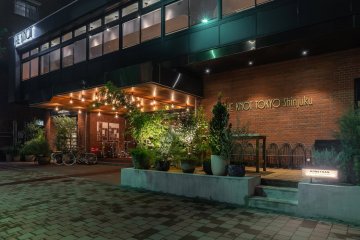
Located right next to Shinjuku Chuo Park, THE KNOT TOKYO Shinjuku is a modern hotel with an exceptional design and easy access to the nearby Shinjuku train station and the Meiji Shrine. The 14-story hotel building was renovated and reopened in August 2018 as THE KNOT TOKYO Shinjuku . The western-style rooms offer a park view on the top floor as well as a newly opened terrace suite. The spacious atrium design offers a relaxed atmosphere and connects the restaurant, bar, lounge and lobby with one another. One of the highlights of THE KNOT is the delicious dishes. There are six areas in which food and drinks are offered. From the grill area to high-quality black tea and fresh bread, everything is on offer.

PIZZERIA & BAR NOHGA is an all day dining restaurant interpreting a fusion of “Spanish Italian” cuisine and has a kitchen to table design. There is a casual bar area and restaurant where you can take a peek inside the open kitchen whilst enjoying your meal. Visit the cafe for a range of coffees and teas along with an offering of tapas snacks and seasonal desserts. The cafe also offers an assorted dessert and all-you-can-drink cafe set. Breakfast takes on the art of sharing, where a range of platters are combined with focaccia and your choice of eggs cooked your way. Coming for lunch? Choose from a selection of pizzas, pastas and salads. Each lunch menu is accompanied with homemade soup, iced tea and focaccia. Dinner time offers a range of exquisite tapas and pizzas that can also be shared. Breakfast: 07:00 - 10:00, Lunch 11:30 - 14:30, Cafe 14:30 - 18:00, Dinner: 18:00 - 23:00 with last order at 10pm.
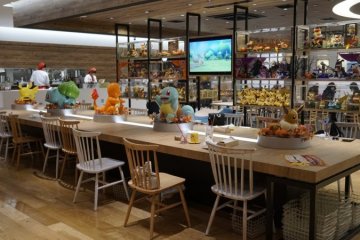
The Pokémon Café in Nihonbashi, which opened in March 2018, is the latest character café in the popular series of games and series in Tokyo. The café and the adjacent Pokémon Center DX store were opened in 1997 on the occasion of the 20th anniversary of the first store. The bright café, which is furnished in warm wood tones, offers main courses, desserts and drinks - all of which are arranged with a focus on one or more Pokémon and some are suitable and limited to certain topics or seasons. You can also find exclusive merchandise here - from plush toys in chef jackets to bowls and cutlery with Pokémon motifs. They also sell Pikachu Sweets, special sweets and products with the most popular of all Pokémon as a motif. A visit to the Pokémon Café is only possible with a prior reservation, time slots can be selected from one month in advance and also in English via the website. It is located on the 5th floor of the Nihombashi Takashimaya Shopping Center, which is not far from the Tokyo and Nihonbashi stations.

Bunny Cafe Moff Rell in Tokyo's Chiyoda Ward offers a chance to interact with adorable rabbits. You can make reservations for the cafe by phone, or you can visit and pay at the store before entering. The cafe provides 30- and 60-minute courses, and you can play with or feed the bunnies. If you are unsure about how to treat the rabbits, don't worry! The staff members will kindly explain everything to you. Minimum age is 10 years old.

The Nippon Budokan, located in Chiyoda, Tokyo, is one of Japan’s most iconic cultural and sporting venues. Originally built for the judo competition in the 1964 Tokyo Olympics, the Budokan has evolved into a revered hall for both martial arts and music performances. Its name, meaning "Martial Arts Hall of Japan," reflects its traditional purpose. Designed with a distinct octagonal roof inspired by Yumedono at Horyu-ji Temple, the building represents a blend of modern construction and traditional Japanese aesthetics. While still regularly hosting national martial arts tournaments such as kendo, aikido, and karate, the Budokan is perhaps equally famous among international visitors for its storied history as a concert venue. In 1966, The Beatles became the first rock band to perform there, sparking controversy at the time due to the venue’s sacred association with martial arts. Since then, legendary artists like Bob Dylan, Queen, and Japanese icons such as X Japan and Hikaru Utada have performed here, making it a pilgrimage site for music lovers. The Budokan is located within Kitanomaru Park, part of the former Edo Castle grounds, which adds natural beauty and historical depth to any visit. The surrounding area, including the Imperial Palace and Chidorigafuchi Moat, is also known for its scenic cherry blossoms in spring. Whether you're attending a martial arts event, a concert, or simply enjoying the park and its historical foundation, the Nippon Budokan offers a unique blend of culture, history, and entertainment.

The National Museum of Modern Art, Tokyo, (abbreviated as MOMAT) is Japan’s first national art museum. The museum was initially founded in 1952 in Chuo Ward, before it was relocated in 1969 to its larger present-day location in Chiyoda Ward beside the Imperial Palace. The sleek facility was designed by architect Yoshio Taniguchi and has undergone multiple renovations and expansions to meet its ever-growing collection. The main building itself extends 4,500 square meters, making it one of Japan’s largest art museums. Aside from the main building, MOMAT also includes the Crafts Gallery, which opened in 1977. This gallery is located in the former Imperial Guards headquarters and is a beautiful example of western-style brick architecture from the Meiji period. The museum has an impressive collection of about 13,000 Japanese- and Western-style pieces from the early 20th century to present day and displays about 200 works at a time. The main hall generally features paintings, prints, watercolors, drawings, sculptures, and photographs, while the Crafts Gallery displays ceramics, glasswork, lacquerware, woodwork, bamboo work, graphic design, and more. MOMAT also includes a museum shop and a French-and-Italian-fusion restaurant.

Yasukuni Shrine (Yasukuni Jinja), located in Chiyoda City, Tokyo, was established in 1869 by Emperor Meiji to commemorate and honor those who gave their lives for their country during war time. Today, the shrine is dedicated to nearly 2.5 million souls from a number of conflicts, including the Boshin War, the Seinan War, World War I, the Manchurian Incident, the China Incident, and World War II. Men, women, and children who supported Japan in roles such as, but not limited to, soldiers, factory workers, and civil service workers are worshipped equally regardless of rank, social status, or gender. The shrine solemnly recognizes the names, origins, birth dates, and places of death of these individuals by listing their information on-site. The shrine stands as a solemn reminder of the effects of war with an atmosphere of both respect and tragedy. Though in recent years, Yasukuni has become one of Japan’s most controversial shrines. History of Yasukuni Shrine Emperor Meiji founded Yasukuni Jinja in 1869 during the second year of the Meiji Restoration. During this time, Japan was going through political reform, which sparked an internal conflict known as the Boshin War, where people in favor of military rule fought individuals who aimed to return power to the Imperial court. After this significant event, Emperor Meiji ordered the construction of Shokonsha Shrine, which he later renamed Yasukuni Jinja in 1879, to honor those who gave their lives for this historic change. Emperor Meiji founded Yasukuni to stand as a symbol of the ultimate sacrifices people made to bring peace to Japan. Today, the shrine is recognized as an Imperial Shrine of Special Status. Controversy In recent years, Yasukuni Jinja has seen some political controversy as fourteen convicted class A war criminals from WWII are enshrined among the deified souls. This has put many of Japan's leading ministers under scrutiny for visiting the shrine, related to the principle of separation of church and state. Today Five million people visit Yasukuni Jinja every year to pay their respects to the enshrined souls. The shrine is free to visit and is open year-round from 6:00 to 18:00 (17:00 from November to February). Yasukuni’s entrance is marked by the dominating Daiichi Torii, which is the first shrine gate and one of the tallest torii’s in Japan, standing at 22 meters tall. As visitors pass the threshold onto the sacred grounds, they are enveloped in an atmosphere of solemn serenity. The traditional, yet not overly-flamboyant architecture coupled with the surrounding nature creates a peaceful environment that honors the enshrined souls. Directly past the torii is a bronze statue of Omura Masujiro, the first Minister of War after the Meiji Restoration. Continuing forward, guests will pass through a second torii, named Daini and then Shinmon, a pagoda-style main gate. The main area of the shrine opens up to a courtyard filled with cherry blossoms, which leads to Haiden Main Hall and Yushukan Museum to the right. Yushukan Museum is an impactful building that tells the stories of the countless enshrined souls. Though the museum has also come under scrutiny due to its conservative and biased retelling of wartime events. The museum has an 800 JPY admission fee and is open from 9:00 to 16:30. For springtime enthusiasts, Yasukuni is also a significant spot as it is home to Tokyo’s representative cherry blossom tree, which is used by meteorologists to announce the official start of the cherry blossom season. Yasukuni Jinja performs daily rituals where it offers food and words of gratitude to the dead, and twice a year, in spring and autumn, it performs major rituals in which offerings by the emperor are consecrated. Members of the imperial family also take part in these rites. The shrine also plays host to numerous Shinto festivals and rituals year-round.